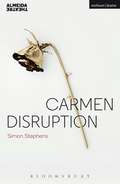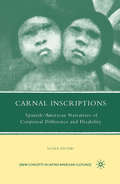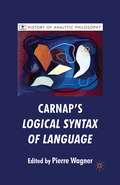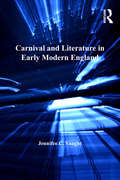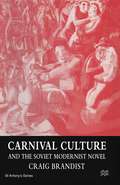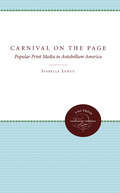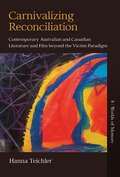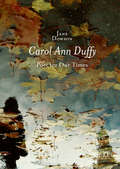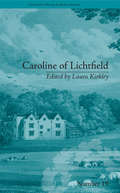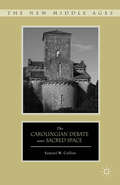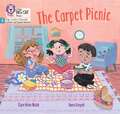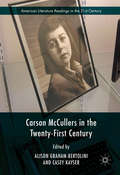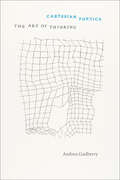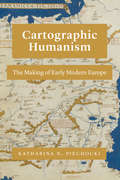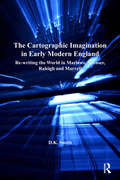- Table View
- List View
Carmen Disruption (Modern Plays)
by Simon StephensI'll gather my breath. I'll walk out of my room. I'll know exactly where I'm going to go. The voice in my head tells me exactly where to go. In the opulent grandeur of a European city, a renowned singer abandons the opera house for the truth of the streets. A gorgeous prostitute. A tough-talking taxi driver. A global trader. A teenage dreamer. Everyone's looking for something.Simon Stephens's strange and beautiful play re-imagines Bizet's opera Carmen and the possibility of love in a fractured urban world. Carmen Disruption received its world premiere at the Deutsche Schauspielhaus, Hamburg, in March 2014 and its UK premiere at the Almeida Theatre on 10 April 2015.
Carmen Disruption: Three Kingdoms; The Trial Of Ubu; Morning; Carmen Disruption (Modern Plays)
by Simon StephensI'll gather my breath. I'll walk out of my room. I'll know exactly where I'm going to go. The voice in my head tells me exactly where to go. In the opulent grandeur of a European city, a renowned singer abandons the opera house for the truth of the streets. A gorgeous prostitute. A tough-talking taxi driver. A global trader. A teenage dreamer. Everyone's looking for something.Simon Stephens's strange and beautiful play re-imagines Bizet's opera Carmen and the possibility of love in a fractured urban world. Carmen Disruption received its world premiere at the Deutsche Schauspielhaus, Hamburg, in March 2014 and its UK premiere at the Almeida Theatre on 10 April 2015.
Carnal Inscriptions: Spanish American Narratives of Corporeal Difference and Disability (New Directions in Latino American Cultures)
by S. AntebiThis book explores manifestations of physical disability in Spanish American narrative fiction and performance, from José Martí's late nineteenth century crónicas, to Mario Bellatín's twenty-first century novels, from the performances of Guillermo Gómez-Peña and Coco Fusco to the testimonio and filmic depictions of Gabriela Brimmer.
Carnap's Logical Syntax of Language (History of Analytic Philosophy)
by P. WagnerThis volume's aim is to provide an introduction to Carnap's book from a historical and philosophical perspective, each chapter focusing on one specific issue. The book will be of interest not only to Carnap scholars but to all those interested in the history of analytical philosophy.
Carnival and Literature in Early Modern England
by Jennifer C. VaughtCarnival and Literature in Early Modern England explores the elite and popular festive materials appropriated by authors during the English Renaissance in a wide range of dramatic and non-dramatic texts. Although historical records of rural, urban, and courtly seasonal customs in early modern England exist only in fragmentary form, Jennifer Vaught traces the sustained impact of festivals and rituals on the plays and poetry of sixteenth- and seventeenth-century English writers. She focuses on the diverse ways in which Shakespeare, Spenser, Marlowe, Dekker, Jonson, Milton and Herrick incorporated the carnivalesque in their works. Further, she demonstrates how these early modern texts were used-and misused-by later writers, performers, and inventors of spectacles, notably Mardi Gras krewes organizing parades in the American Deep South. The works featured here often highlight violent conflicts between individuals of different ranks, ethnicities, and religions, which the author argues reflect the social realities of the time. These Renaissance writers responded to republican, egalitarian notions of liberty for the populace with radical support, ambivalence, or conservative opposition. Ultimately, the vital, folkloric dimension of these plays and poems challenges the notion that canonical works by Shakespeare and his contemporaries belong only to 'high' and not to 'low' culture.
Carnival and Literature in Early Modern England
by Jennifer C. VaughtCarnival and Literature in Early Modern England explores the elite and popular festive materials appropriated by authors during the English Renaissance in a wide range of dramatic and non-dramatic texts. Although historical records of rural, urban, and courtly seasonal customs in early modern England exist only in fragmentary form, Jennifer Vaught traces the sustained impact of festivals and rituals on the plays and poetry of sixteenth- and seventeenth-century English writers. She focuses on the diverse ways in which Shakespeare, Spenser, Marlowe, Dekker, Jonson, Milton and Herrick incorporated the carnivalesque in their works. Further, she demonstrates how these early modern texts were used-and misused-by later writers, performers, and inventors of spectacles, notably Mardi Gras krewes organizing parades in the American Deep South. The works featured here often highlight violent conflicts between individuals of different ranks, ethnicities, and religions, which the author argues reflect the social realities of the time. These Renaissance writers responded to republican, egalitarian notions of liberty for the populace with radical support, ambivalence, or conservative opposition. Ultimately, the vital, folkloric dimension of these plays and poems challenges the notion that canonical works by Shakespeare and his contemporaries belong only to 'high' and not to 'low' culture.
Carnival Culture and the Soviet Modernist Novel (St Antony's Series)
by Craig BrandistThis book examines the work of five Soviet prose writers - Olesha, Platonov, Kharms, Bulgakov and Vaginov - in the light of the carnivalesque elements of Russian popular culture. It shows that while Bakhtin's account of carnival culture sheds considerable light on the work of these writers, they need to be considered with reference to both the concrete forms of Russian and Soviet popular culture and the changing institutional framework of Soviet society in the 1920s and 1930s.
Carnival on the Page: Popular Print Media in Antebellum America
by Isabelle LehuuIn the decades before the Civil War, American society witnessed the emergence of a new form of print culture, as penny papers, mammoth weeklies, giftbooks, fashion magazines, and other ephemeral printed materials brought exuberance and theatricality to public culture and made the practice of reading more controversial. For a short yet pivotal period, argues Isabelle Lehuu, the world of print was turned upside down. Unlike the printed works of the eighteenth century, produced to educate and refine, the new media aimed to entertain a widening yet diversified public of men and women. As they gained popularity among American readers, these new print forms provoked fierce reactions from cultural arbiters who considered them transgressive. No longer the manly art of intellectual pursuit, reading took on new meaning; reading for pleasure became an act with the power to silently disrupt the social order.Neither just an epilogue to an earlier age of scarce books and genteel culture nor merely a prologue to the late nineteenth century and its mass culture and commercial literature, the antebellum era marked a significant passage in the history of books and reading in the United States, Lehuu argues.Originally published 2000.A UNC Press Enduring Edition -- UNC Press Enduring Editions use the latest in digital technology to make available again books from our distinguished backlist that were previously out of print. These editions are published unaltered from the original, and are presented in affordable paperback formats, bringing readers both historical and cultural value.
Carnivalizing Reconciliation: Contemporary Australian and Canadian Literature and Film beyond the Victim Paradigm (Worlds of Memory #8)
by Hanna TeichlerCriminal justice inquiries may be the most historically dramatic means for coming to terms with traumatic legacies, but it is in the more subtle social and cultural processes of “memory work” that most individuals encounter historical reconciliation in practice. This book analyzes, within the realms of national literature and film, recent Australian and Canadian attempts to reconcile with Indigenous populations in the wake of forced child removal. As Hanna Teichler demonstrates, their systematic emphasis on the subjectivity of the victim is “carnivalesque,” temporarily overturning discursive hierarchies. Such fictions of reconciliation venture beyond simplistic narratives and identities defined by victimization, offering new opportunities for confronting painful histories.
Carol Ann Duffy: Poet for Our Times
by Jane DowsonThis is the only monograph to consider the entire thirty-year career, publications, and influence of Britain's first female poet laureate. It outlines her impact on trends in contemporary poetry and establishes what we mean by ‘Duffyesque’ concerns and techniques. Discussions of her writing and activities prove how she has championed the relevance of poetry to all areas of contemporary culture and to the life of every human being. Individual chapters discuss the lyrics of ‘love, loss, and longing’; the socially motivated poems about the 1980s; the female-centred volumes and poems; the relationship between poetry and public life; and poetry and childhood and written for children. The book should whet the appetite of readers who know little of Duffy’s work to find out more, while providing students and scholars with an in-depth analysis of the poems in their contexts. It draws on a wide range of critical works and includes an extensive list of further reading.
Caroline of Lichtfield: by Isabelle de Montolieu (Chawton House Library: Women's Novels #19)
by Laura KirkleyThomas Holcroft’s 1786 translation of Isabelle de Montolieu’s novel is a textual encounter between a rather conventional Swiss woman and a British radical. Just as Montolieu did in her own translations, Holcroft reworked parts of the novel to make it more appealing to his intended audience.
Caroline of Lichtfield: by Isabelle de Montolieu (Chawton House Library: Women's Novels)
by Laura KirkleyThomas Holcroft’s 1786 translation of Isabelle de Montolieu’s novel is a textual encounter between a rather conventional Swiss woman and a British radical. Just as Montolieu did in her own translations, Holcroft reworked parts of the novel to make it more appealing to his intended audience.
The Carolingian Debate over Sacred Space (The New Middle Ages)
by S. CollinsRetracing the contours of a bitter controversy over the meaning of sacred architecture that flared up among some of the leading lights of the Carolingian renaissance, Collins explores how ninth-century authors articulated the relationship of form to function and ideal to reality in the ecclesiastical architecture of the Carolingian empire.
The Carpet Picnic: Phase 3 Set 2 (Big Cat Phonics For Little Wandle Letters And Sounds Revised Ser.)
by Clare Helen Welsh Asma Enayeh Collins Big CatCarson McCullers in the Twenty-First Century (American Literature Readings in the 21st Century)
by Alison Graham-Bertolini and Casey KayserThe contributors to this volume use diverse critical techniques to identify how Carson McCullers’ writing engages with and critiques modern social structures and how her work resonates with a twenty-first century audience. The collection includes chapters about McCullers’ fiction, autobiographical writing, and dramatic works, and is groundbreaking because it includes the first detailed scholarly examination of new archival material donated to Columbus State University after the 2013 death of Dr. Mary Mercer, McCullers’ psychiatrist and friend, including transcripts of the psychiatric sessions that took place between McCullers and Mercer in 1958. Further, the collection covers the scope of McCullers’ canon of work, such as The Heart Is a Lonely Hunter (1940), The Member of the Wedding (1946), and Ballad of the Sad Café (1943), through lenses that are of growing interest in contemporary literary studies, including comparative transatlantic readings, queer theory, disability studies, and critical animal theory, among others.
Cartesian Poetics: The Art of Thinking (Thinking Literature)
by Andrea GadberryWhat is thinking? What does it feel like? What is it good for? Andrea Gadberry looks for answers to these questions in the philosophy of René Descartes and finds them in the philosopher’s implicit poetics. Gadberry argues that Descartes’s thought was crucially enabled by poetry and shows how markers of poetic genres from love lyric and elegy to the puzzling forms of the riddle and the anagram betray an impassioned negotiation with the difficulties of thought and its limits. Where others have seen Cartesian philosophy as a triumph of reason, Gadberry reveals that the philosopher accused of having “slashed poetry’s throat” instead enlisted poetic form to contain thought’s frustrations. Gadberry’s approach to seventeenth-century writings poses questions urgent for the twenty-first. Bringing literature and philosophy into rich dialogue, Gadberry centers close reading as a method uniquely equipped to manage skepticism, tolerate critical ambivalence, and detect feeling in philosophy. Helping us read classic moments of philosophical argumentation in a new light, this elegant study also expands outward to redefine thinking in light of its poetic formations.
Cartesian Poetics: The Art of Thinking (Thinking Literature)
by Andrea GadberryWhat is thinking? What does it feel like? What is it good for? Andrea Gadberry looks for answers to these questions in the philosophy of René Descartes and finds them in the philosopher’s implicit poetics. Gadberry argues that Descartes’s thought was crucially enabled by poetry and shows how markers of poetic genres from love lyric and elegy to the puzzling forms of the riddle and the anagram betray an impassioned negotiation with the difficulties of thought and its limits. Where others have seen Cartesian philosophy as a triumph of reason, Gadberry reveals that the philosopher accused of having “slashed poetry’s throat” instead enlisted poetic form to contain thought’s frustrations. Gadberry’s approach to seventeenth-century writings poses questions urgent for the twenty-first. Bringing literature and philosophy into rich dialogue, Gadberry centers close reading as a method uniquely equipped to manage skepticism, tolerate critical ambivalence, and detect feeling in philosophy. Helping us read classic moments of philosophical argumentation in a new light, this elegant study also expands outward to redefine thinking in light of its poetic formations.
Cartesian Poetics: The Art of Thinking (Thinking Literature)
by Andrea GadberryWhat is thinking? What does it feel like? What is it good for? Andrea Gadberry looks for answers to these questions in the philosophy of René Descartes and finds them in the philosopher’s implicit poetics. Gadberry argues that Descartes’s thought was crucially enabled by poetry and shows how markers of poetic genres from love lyric and elegy to the puzzling forms of the riddle and the anagram betray an impassioned negotiation with the difficulties of thought and its limits. Where others have seen Cartesian philosophy as a triumph of reason, Gadberry reveals that the philosopher accused of having “slashed poetry’s throat” instead enlisted poetic form to contain thought’s frustrations. Gadberry’s approach to seventeenth-century writings poses questions urgent for the twenty-first. Bringing literature and philosophy into rich dialogue, Gadberry centers close reading as a method uniquely equipped to manage skepticism, tolerate critical ambivalence, and detect feeling in philosophy. Helping us read classic moments of philosophical argumentation in a new light, this elegant study also expands outward to redefine thinking in light of its poetic formations.
Cartesian Poetics: The Art of Thinking (Thinking Literature)
by Andrea GadberryWhat is thinking? What does it feel like? What is it good for? Andrea Gadberry looks for answers to these questions in the philosophy of René Descartes and finds them in the philosopher’s implicit poetics. Gadberry argues that Descartes’s thought was crucially enabled by poetry and shows how markers of poetic genres from love lyric and elegy to the puzzling forms of the riddle and the anagram betray an impassioned negotiation with the difficulties of thought and its limits. Where others have seen Cartesian philosophy as a triumph of reason, Gadberry reveals that the philosopher accused of having “slashed poetry’s throat” instead enlisted poetic form to contain thought’s frustrations. Gadberry’s approach to seventeenth-century writings poses questions urgent for the twenty-first. Bringing literature and philosophy into rich dialogue, Gadberry centers close reading as a method uniquely equipped to manage skepticism, tolerate critical ambivalence, and detect feeling in philosophy. Helping us read classic moments of philosophical argumentation in a new light, this elegant study also expands outward to redefine thinking in light of its poetic formations.
Cartographic Humanism: The Making of Early Modern Europe
by Katharina N. PiechockiWhat is “Europe,” and when did it come to be? In the Renaissance, the term “Europe” circulated widely. But as Katharina N. Piechocki argues in this compelling book, the continent itself was only in the making in the fifteenth and sixteenth centuries. Cartographic Humanism sheds new light on how humanists negotiated and defined Europe’s boundaries at a momentous shift in the continent’s formation: when a new imagining of Europe was driven by the rise of cartography. As Piechocki shows, this tool of geography, philosophy, and philology was used not only to represent but, more importantly, also to shape and promote an image of Europe quite unparalleled in previous centuries. Engaging with poets, historians, and mapmakers, Piechocki resists an easy categorization of the continent, scrutinizing Europe as an unexamined category that demands a much more careful and nuanced investigation than scholars of early modernity have hitherto undertaken. Unprecedented in its geographic scope, Cartographic Humanism is the first book to chart new itineraries across Europe as it brings France, Germany, Italy, Poland, and Portugal into a lively, interdisciplinary dialogue.
Cartographic Humanism: The Making of Early Modern Europe
by Katharina N. PiechockiWhat is “Europe,” and when did it come to be? In the Renaissance, the term “Europe” circulated widely. But as Katharina N. Piechocki argues in this compelling book, the continent itself was only in the making in the fifteenth and sixteenth centuries. Cartographic Humanism sheds new light on how humanists negotiated and defined Europe’s boundaries at a momentous shift in the continent’s formation: when a new imagining of Europe was driven by the rise of cartography. As Piechocki shows, this tool of geography, philosophy, and philology was used not only to represent but, more importantly, also to shape and promote an image of Europe quite unparalleled in previous centuries. Engaging with poets, historians, and mapmakers, Piechocki resists an easy categorization of the continent, scrutinizing Europe as an unexamined category that demands a much more careful and nuanced investigation than scholars of early modernity have hitherto undertaken. Unprecedented in its geographic scope, Cartographic Humanism is the first book to chart new itineraries across Europe as it brings France, Germany, Italy, Poland, and Portugal into a lively, interdisciplinary dialogue.
Cartographic Humanism: The Making of Early Modern Europe
by Katharina N. PiechockiWhat is “Europe,” and when did it come to be? In the Renaissance, the term “Europe” circulated widely. But as Katharina N. Piechocki argues in this compelling book, the continent itself was only in the making in the fifteenth and sixteenth centuries. Cartographic Humanism sheds new light on how humanists negotiated and defined Europe’s boundaries at a momentous shift in the continent’s formation: when a new imagining of Europe was driven by the rise of cartography. As Piechocki shows, this tool of geography, philosophy, and philology was used not only to represent but, more importantly, also to shape and promote an image of Europe quite unparalleled in previous centuries. Engaging with poets, historians, and mapmakers, Piechocki resists an easy categorization of the continent, scrutinizing Europe as an unexamined category that demands a much more careful and nuanced investigation than scholars of early modernity have hitherto undertaken. Unprecedented in its geographic scope, Cartographic Humanism is the first book to chart new itineraries across Europe as it brings France, Germany, Italy, Poland, and Portugal into a lively, interdisciplinary dialogue.
Cartographic Humanism: The Making of Early Modern Europe
by Katharina N. PiechockiWhat is “Europe,” and when did it come to be? In the Renaissance, the term “Europe” circulated widely. But as Katharina N. Piechocki argues in this compelling book, the continent itself was only in the making in the fifteenth and sixteenth centuries. Cartographic Humanism sheds new light on how humanists negotiated and defined Europe’s boundaries at a momentous shift in the continent’s formation: when a new imagining of Europe was driven by the rise of cartography. As Piechocki shows, this tool of geography, philosophy, and philology was used not only to represent but, more importantly, also to shape and promote an image of Europe quite unparalleled in previous centuries. Engaging with poets, historians, and mapmakers, Piechocki resists an easy categorization of the continent, scrutinizing Europe as an unexamined category that demands a much more careful and nuanced investigation than scholars of early modernity have hitherto undertaken. Unprecedented in its geographic scope, Cartographic Humanism is the first book to chart new itineraries across Europe as it brings France, Germany, Italy, Poland, and Portugal into a lively, interdisciplinary dialogue.
Cartographic Humanism: The Making of Early Modern Europe
by Katharina N. PiechockiPiechocki calls for an examination of the idea of Europe as a geographical concept, tracing its development in the 15th and 16th centuries. What is “Europe,” and when did it come to be? In the Renaissance, the term “Europe” circulated widely. But as Katharina N. Piechocki argues in this compelling book, the continent itself was only in the making in the fifteenth and sixteenth centuries. Cartographic Humanism sheds new light on how humanists negotiated and defined Europe’s boundaries at a momentous shift in the continent’s formation: when a new imagining of Europe was driven by the rise of cartography. As Piechocki shows, this tool of geography, philosophy, and philology was used not only to represent but, more importantly, also to shape and promote an image of Europe quite unparalleled in previous centuries. Engaging with poets, historians, and mapmakers, Piechocki resists an easy categorization of the continent, scrutinizing Europe as an unexamined category that demands a much more careful and nuanced investigation than scholars of early modernity have hitherto undertaken. Unprecedented in its geographic scope, Cartographic Humanism is the first book to chart new itineraries across Europe as it brings France, Germany, Italy, Poland, and Portugal into a lively, interdisciplinary dialogue.
The Cartographic Imagination in Early Modern England: Re-writing the World in Marlowe, Spenser, Raleigh and Marvell
by D.K. SmithWorking from a cultural studies perspective, author D. K. Smith here examines a broad range of medieval and Renaissance maps and literary texts to explore the effects of geography on Tudor-Stuart cultural perceptions. He argues that the literary representation of cartographically-related material from the late fifteenth to the early seventeenth century demonstrates a new strain, not just of geographical understanding, but of cartographic manipulation, which he terms, "the cartographic imagination." Rather than considering the effects of maps themselves on early modern epistemologies, Smith considers the effects of the activity of mapping-the new techniques, the new expectations of accuracy and precision which developed in the sixteenth century-on the ways people thought and wrote. Looking at works by Spenser, Marlowe, Raleigh, and Marvell among other authors, he analyzes how the growing ability to represent physical space accurately brought with it not just a wealth of new maps, but a new array of rhetorical techniques, metaphors, and associations which allowed the manipulation of texts and ideas in ways never before possible.
